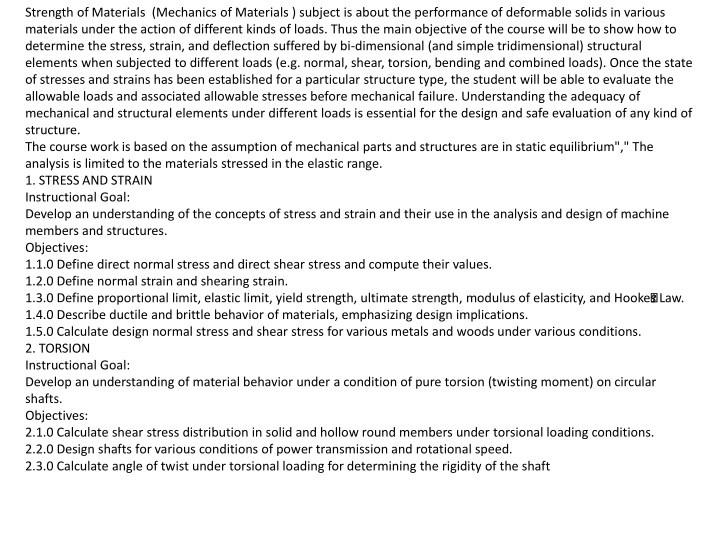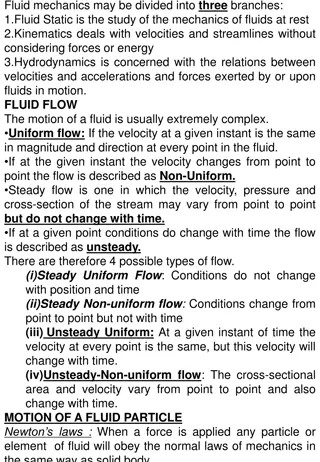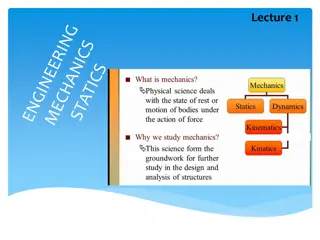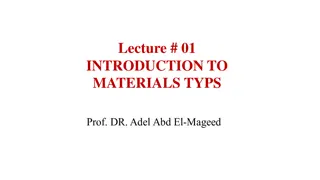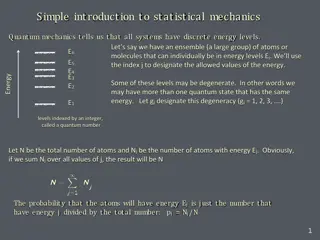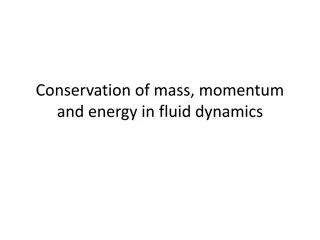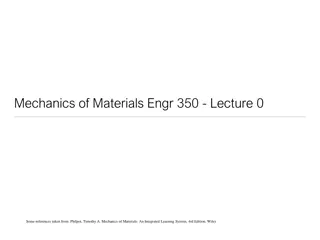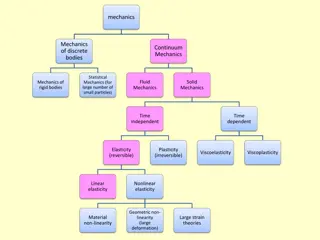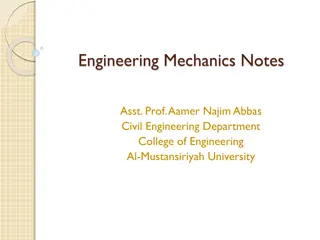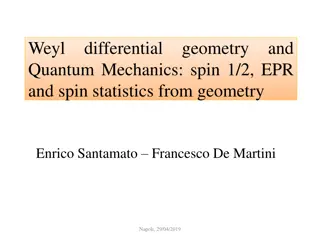Mechanics of Materials Fundamentals
This subject delves into the behavior of deformable solids under various loads, focusing on stress, strain, and deflection analysis in structural elements. The course covers topics like stress and strain, torsion, beam analysis, combined stresses, and column design. Students will learn how to determine allowable loads and stresses to ensure structural integrity. References to textbooks and video resources are provided for further study and problem-solving practice.
Download Presentation

Please find below an Image/Link to download the presentation.
The content on the website is provided AS IS for your information and personal use only. It may not be sold, licensed, or shared on other websites without obtaining consent from the author.If you encounter any issues during the download, it is possible that the publisher has removed the file from their server.
You are allowed to download the files provided on this website for personal or commercial use, subject to the condition that they are used lawfully. All files are the property of their respective owners.
The content on the website is provided AS IS for your information and personal use only. It may not be sold, licensed, or shared on other websites without obtaining consent from the author.
E N D
Presentation Transcript
Strength of Materials (Mechanics of Materials ) subject is about the performance of deformable solids in various materials under the action of different kinds of loads. Thus the main objective of the course will be to show how to determine the stress, strain, and deflection suffered by bi-dimensional (and simple tridimensional) structural elements when subjected to different loads (e.g. normal, shear, torsion, bending and combined loads). Once the state of stresses and strains has been established for a particular structure type, the student will be able to evaluate the allowable loads and associated allowable stresses before mechanical failure. Understanding the adequacy of mechanical and structural elements under different loads is essential for the design and safe evaluation of any kind of structure. The course work is based on the assumption of mechanical parts and structures are in static equilibrium"," The analysis is limited to the materials stressed in the elastic range. 1. STRESS AND STRAIN Instructional Goal: Develop an understanding of the concepts of stress and strain and their use in the analysis and design of machine members and structures. Objectives: 1.1.0 Define direct normal stress and direct shear stress and compute their values. 1.2.0 Define normal strain and shearing strain. 1.3.0 Define proportional limit, elastic limit, yield strength, ultimate strength, modulus of elasticity, and Hooke s Law. 1.4.0 Describe ductile and brittle behavior of materials, emphasizing design implications. 1.5.0 Calculate design normal stress and shear stress for various metals and woods under various conditions. 2. TORSION Instructional Goal: Develop an understanding of material behavior under a condition of pure torsion (twisting moment) on circular shafts. Objectives: 2.1.0 Calculate shear stress distribution in solid and hollow round members under torsional loading conditions. 2.2.0 Design shafts for various conditions of power transmission and rotational speed. 2.3.0 Calculate angle of twist under torsional loading for determining the rigidity of the shaft
Instructional Goal: Develop an understanding of the models and procedures used in the analysis of transversely loaded beams and shafts with various support conditions. Objectives: 3.1.0 Determine shear and bending moment diagrams for variously loaded and supported beams, using graphical calculus. 3.2.0 Calculate bending stress and shear stress at any location along the beam. Calculate maximum bending stress and maximum shear stress. 3.3.0 Determine the maximum deflection on statically determinate beams, using the method of superposition in reflection analysis. 3.4.0 Design beams based on allowable normal and shear stresses and maximum allowable deflection. 4. COMBINED STRESSES Instructional Goal: Gain the ability to analyze the effect of various loading combinations on a mechanical/structural member. Objectives: 4.1.0 Determine principal stresses, principal planes and maximum shear stress under various combinations of bending, torsion and axial loads on machine and structural parts using Mohr s circle. 5. COLUMNS Instructional Goal: Develop an understanding of analytic methods used in connection with the structural design of columns, long mechanical members under compression. Objectives: 5.1.0 Apply the Euler Equation to calculate axial buckling load for long straight columns of varying end conditions and materials.
Textbook: Hibbeler, R.C., Mechanics of Materials, 7th edition, The book is available for all students by the Department. Reference Books:1- Pytel Andrew, Jaan Kiusalaas., Mechanics of Materials Second Edition 2. Ferdinand P Beer, E Russell Johnston, Jr. John T Dewolf.3. Mechanics of Materials, 5th Edition. Beer, F.P., Johnston, E.R., DeWolf, J.T.,4. Mechanics of Materials , 4th edition, McGraw Hill. Craig, R.R., Mechanics of Materials , 2nd edition, John Wiley and Sons. Video Flashes used to illustrate the topics and examples of each lecture http://web.mst.edu/~mecmovie/ The students will be able to use a software program to solve the problems & to be able to make problems by themselves. http://www.mdsolids.com/
Why Mechanics of Materials? (Why is Statics not enough?) Real world structures are typically designed for strength, stiffness, and stability considerations. None of these can be accomplished with what we have learned in Statics Strength: The ability of the structures to carry or transmit loads. Stiffness: The ability of the structures to resist changes in shape. Stability: The ability of the structure to resist buckling under compressive loads. INTRODUCTION Mechanics of materials is a branch of mechanics that studies the relationships between the external loads applied to a deformable body and the intensity of internal force acting within the body. The subject also involves computing the deformations of the body, and it provides a study of the body s stability when the body is subjected to external forces.
External Loads are caused by the direct contact of one body with the surface of another. Concentrated Force idealization this area is small in comparison with the total surface force can be idealized as a single concentrated force, which is applied to a point on the body. Linear Distributed load idealization If the surface loading is applied along a narrow area. Body Force Is developed when one boy exerts a force on another body without direct physical contact between the bodies. Gravitation, this force called the weight of the body.
Internal Forces Normal force, N=> the force acts perpendicular to the area. It is developed whenever the external loads tend to push or pull on the two segments of the body. Shear force, V=> the shear force lies in the plane of the area and is developed when external loads tend to cause the two segments of the body to slide over one another. Torsional moment or torque, T=> this effect is developed when the external loads tend to twist one segment of the body within respect to the other. Bending moment, M=> the bending moment is caused by the external loads that tend to bend the body about an axis lying within the plane of the area.
Equilibrium of a Deformable Body Units (SI system) Newtons per square meter (N/m2) or a pascal(1 Pa = 1 N/m2) kPa= 103N/m2(kilo-pascal) MPa= 106N/m2(mega-pascal) GPa= 109N/m2(giga-pascal
